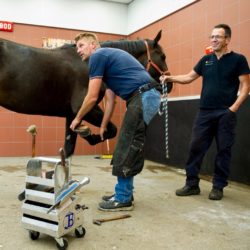Mustad’s customer-driven supply chain

Companies with a customer intimacy strategy make decisions based on customer demand. But when is the best time to make a particular type of decision? During a SCM Professionals Club workshop held by Mustad, the market leader in hoofcare products, it became clear that you should make decisions early if possible and late if necessary.
By Marysa Vos
The Mustad Hoofcare Group has pioneered technological breakthroughs in metal-based products for close to two centuries, and has also become the world’s biggest manufacturer and supplier of hoofcare products. This Norwegian family business has been pursuing a customer intimacy strategy for the past 187 years, serving customers such as farriers, horse owners and vets. The growth and future success of the company depend on both vertical and horizontal integration. Aided by its own knowledge and market insights, the company is continuously developing and improving its products and brand. Nowadays, with eight factories and locations in 11 different countries, Mustad Hoofcare is run by Hans Mustad, the seventh generation of the Mustad family.
Mustad: horse-based business model
Just like human nails, horses’ hooves grow continually and need trimming and re-shoeing every six to eight weeks. Mustad’s product groups address these needs and include horseshoes, horse nails, rasps and other accessories. Mustad is active in almost a hundred different countries around the world and supplies a number of market-leading products. During the Mustad workshop, which was held at the Animal Health Faculty (Horse Department) of the University of Utrecht, a variety of Mustad’s products could be seen in practice during a horse-shoeing demonstration by a farrier.
Breaking the service paradox
Alex Tjalsma from Involvation also participated in the workshop to explain more about demand-driven supply chain management (DDSCM). If companies want to continue to make progress like Mustad has done, they must make decisions in line with market needs, he said. However, they risk getting caught up in a service paradox: should they focus on making better products or cheaper ones? “If you go for better, you increase the service experience but your productivity will decline, and vice versa,” stated Tjalsma. So how can companies break this service paradox? “You have to act in the interest of the supply chain and achieve alignment.”
In that context, planning entails making decisions about the future. “That’s no problem if you know how the future will look. But if you don’t, it’s a recipe for disaster,” he continued. He used an example involving dice to illustrate how much variability there can be in the amount of time maintenance engineers need when making home visits. What is the normal approach to planning the number of visits per day, and how else could this be done? Should you plan in the number of visits that you’re sure of completing? Or should you plan based on service? In that case, there will be some less productive days. If you plan in the maximum possible number of visits, not all jobs will get completed on some days which will result in poor service.
Wheel of Five of DDSCM
Based on the ‘Wheel of Five of DDSCM’, Tjalsma highlighted five complementary principles for breaking the service paradox: 1) Eliminate waste of capacity, stock and time, 2) Eliminate unnecessary variation in supply and demand, 3) Absorb unpredictable variation with stock and time, 4) Chase predictable variation with insight into variation, potential flexibility and effective decision-making, and 5) Avoid overload by controlling the workload and keeping spare capacity.
To gain broad acceptance of the concept of DDSCM and enable companies to apply this approach, however, it appears to be essential to have clear practical examples of these five principles.








